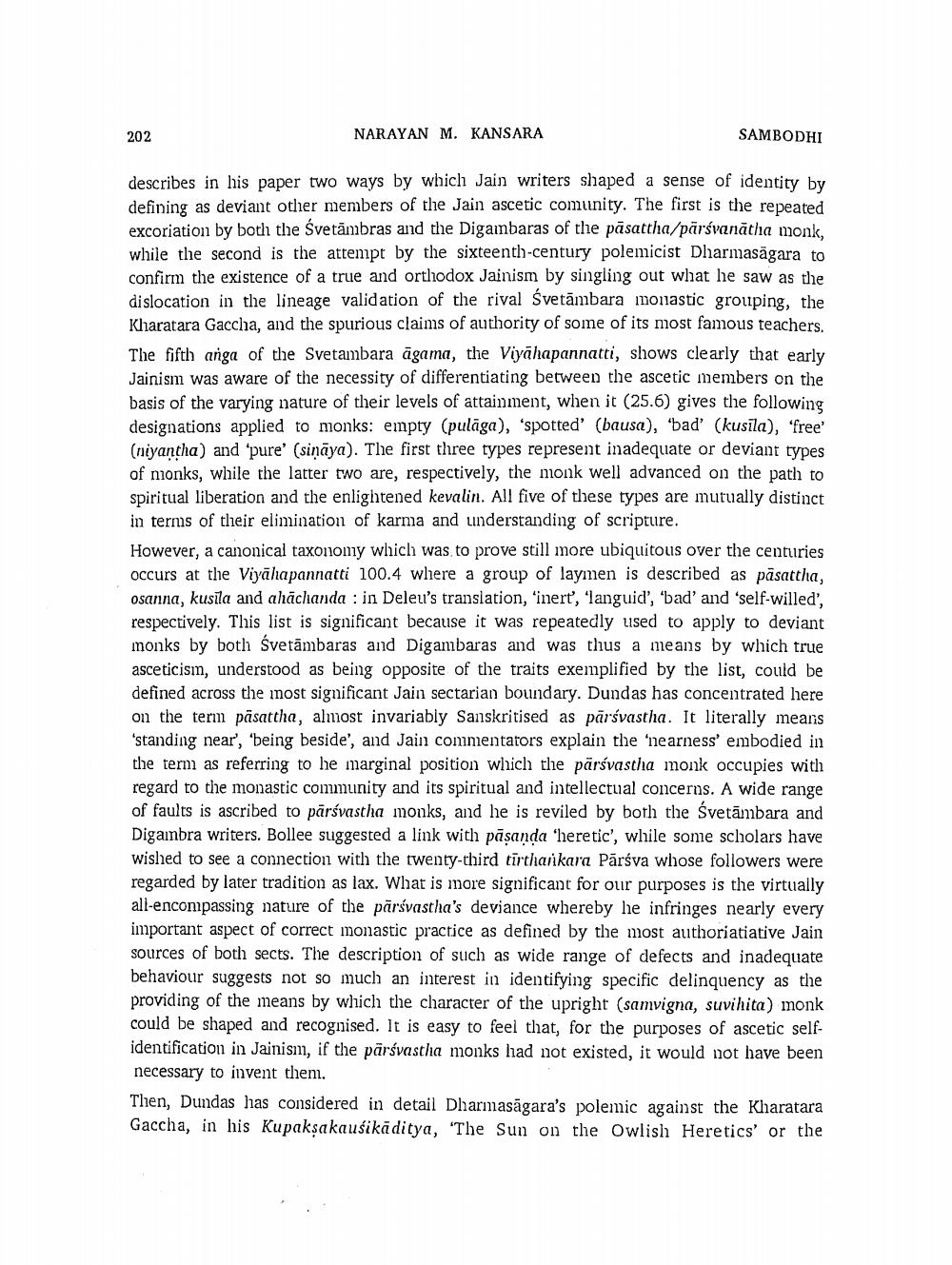________________
202
NARAYAN M. KANSARA
SAMBODHI
describes in his paper two ways by which Jain writers shaped a sense of identity by defining as deviant other members of the Jain ascetic comunity. The first is the repeated excoriation by both the Svetāmbras and the Digambaras of the pā sattha/pārsvanātha monk. while the second is the attempt by the sixteenth-century polemicist Dharmasagara to confirm the existence of a true and orthodox Jainism by singling out what he saw as the dislocation in the lineage validation of the rival Svetāmbara monastic grouping, the Kharatara Gaccha, and the spurious claims of authority of some of its most famous teachers. The fifth anga of the Svetambara agama, the Viyahapannatti, shows clearly that early Jainism was aware of the necessity of differentiating between the ascetic members on the basis of the varying nature of their levels of attainment, when it (25.6) gives the following designations applied to monks: empty (pulāga), 'spotted' (bausa), bad' (kusīla), 'free' (niyantha) and 'pure' (sināya). The first three types represent inadequate or deviant types of monks, while the latter two are, respectively, the monk well advanced on the path to spiritual liberation and the enlightened kevalin. All five of these types are mutually distinct in terms of their elimination of karma and understanding of scripture. However, a canonical taxonomy which was to prove still more ubiquitous over the centuries occurs at the Viyalapannatti 100.4 wliere a group of laymen is described as pāsattha, osanna, kusīta and ahāchanda : in Deleu's translation, 'inert', 'languid', 'bad' and 'self-willed', respectively. This list is significant because it was repeatedly used to apply to deviant monks by both Svetāmbaras and Digambaras and was thus a means by which true asceticism, understood as being opposite of the traits exemplified by the list, could be defined across the inost significant Jain sectarian boundary. Dundas has concentrated here on the term pāsattha, almost invariably Sanskritised as pārsvastha. It literally means 'standing near', 'being beside', and Jain commentators explain the 'nearness' embodied in the term as referring to he marginal position which the pārsvastha monk occupies with regard to the monastic community and its spiritual and intellectual concerns. A wide range of faults is ascribed to pārsvastha monks, and he is reviled by both the svetāmbara and Digambra writers. Bollee suggested a link with pāşanda 'heretic', while some scholars have wished to see a connection with the twenty-third tirtharikara Pārsva whose followers were regarded by later tradition as lax. What is more significant for our purposes is the virtually all-encompassing nature of the pārsvastha's deviance whereby he infringes nearly every important aspect of correct monastic practice as defined by the most authoriatiative Jain sources of both sects. The description of such as wide range of defects and inadequate behaviour suggests not so much an interest in identifying specific delinquency as the providing of the means by which the character of the upright (samvigna, suvihita) monk could be shaped and recognised. It is easy to feel that, for the purposes of ascetic selfidentification in Jainism, if the pārsvastha monks had not existed, it would not have been necessary to invent them.
Then, Dundas las considered in detail Dharmasagara's polemic against the Kharatara Gaccha, in his Kupaksakausikāditya, 'The Sun on the Owlish Heretics' or the




